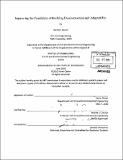| dc.contributor.advisor | Jerome J. Connor. | en_US |
| dc.contributor.author | Quinn, Karen E. (Karen Elizabeth) | en_US |
| dc.contributor.other | Massachusetts Institute of Technology. Dept. of Civil and Environmental Engineering. | en_US |
| dc.date.accessioned | 2011-01-26T14:23:12Z | |
| dc.date.available | 2011-01-26T14:23:12Z | |
| dc.date.copyright | 2010 | en_US |
| dc.date.issued | 2010 | en_US |
| dc.identifier.uri | http://hdl.handle.net/1721.1/60780 | |
| dc.description | Thesis (M. Eng.)--Massachusetts Institute of Technology, Dept. of Civil and Environmental Engineering, 2010. | en_US |
| dc.description | Cataloged from PDF version of thesis. | en_US |
| dc.description | Includes bibliographical references (p. 91-93). | en_US |
| dc.description.abstract | Design for Adaptability and Deconstruction (DfAD) is an emerging trend in the construction industry that focuses on the end-of-life aspect of buildings. It is based on the concept that the life of a building or building component ends because it is unable to adapt to change. With proper implementation, DfAD is an important tool to achieve sustainable design for buildings, as it ideally may form a closed materials loop for construction materials by optimizing the amount of materials salvaged at the end of a building's useful life through deconstruction. This thesis focuses on ways to improve the feasibility of deconstruction and material savings, primarily through DfAD. By implementing DfAD principles and guidelines, designing with reusable materials, and planning and implementing a project effectively, the current practical and economic barriers to deconstruction may be mitigated. This thesis presents the essential considerations for deconstruction and materials salvage and presents potential policies to improve its viability. Three case studies present the applications of DfAD approaches and the lessons learned from common challenges associated with deconstruction. | en_US |
| dc.description.statementofresponsibility | by Karen E. Quinn. | en_US |
| dc.format.extent | 93 p. | en_US |
| dc.language.iso | eng | en_US |
| dc.publisher | Massachusetts Institute of Technology | en_US |
| dc.rights | M.I.T. theses are protected by
copyright. They may be viewed from this source for any purpose, but
reproduction or distribution in any format is prohibited without written
permission. See provided URL for inquiries about permission. | en_US |
| dc.rights.uri | http://dspace.mit.edu/handle/1721.1/7582 | en_US |
| dc.subject | Civil and Environmental Engineering. | en_US |
| dc.title | Improving the feasibility of building deconstruction and adaptability | en_US |
| dc.type | Thesis | en_US |
| dc.description.degree | M.Eng. | en_US |
| dc.contributor.department | Massachusetts Institute of Technology. Department of Civil and Environmental Engineering | |
| dc.identifier.oclc | 693952408 | en_US |
